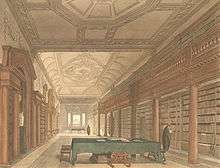John Phillips (c. 1709–75)
John Phillips (c. 1709 – 28 December 1775) was a prominent English master carpenter, builder, and architect who was active in London.
He inherited the considerable practice of his uncle, Thomas Phillips (c. 1689–1736), who was active as a speculative builder on the Harley estate, held the contract for carpentry and joiner's work at James Gibbs' St Martin-in-the-Fields and St Peter's, Vere Street, and built the wooden bridge across the Thames between Fulham and Putney (1729–30).[1]

In partnership with George Shakespear, John Phillips developed Charles Street, Mayfair (1750) and other blocks of land in London's West End. Phillips was the "undertaker" for the whole north-west corner of the Grosvenor estate.[2] Phillips built a grand house for Lord Bateman (1759–60) at the north end of Park Lane, and next to it Camelford House (1773–74) for Thomas Pitt, 1st Baron Camelford.[3] A subcontractor for carving documented in 1773 was John Linnell, a prominent cabinetmaker.[4]
In Oxford, Phillips constructed James Gibbs's wooden dome for the Radcliffe Camera and provided refined joinery in the building (1742–50). Phillips and Shakespear were also responsible for the interior joinery of Christ Church Library (1752–62, illustration, right).
For James West, Phillips and Shakespear extended Alscot Park, Warwickshire, (1750–52), with a north wing and a rebuilt south wing (1762–66)[5] in a Gothick manner that Howard Colvin finds akin to designs by Batty Langley.[6] For Elizabeth, Countess of Portsmouth, Phillips and Shakespear demolished the east wings and parts of the north and south wings of Audley End.
In 1771–72, Phillips constructed the wooden bridge at Battersea, under the direction of the architect Henry Holland. It was demolished in 1881.[7]
During his career he held the post of Carpenter to His Majesty's Board of Works.[8]
From his uncle, Phillips inherited the house in Brook Street that he occupied throughout his career; it survives as 39, Lower Brook Street, remodelled by a later occupant, Sir Jeffry Wyatville.[9] In his retirement, he occupied and built Culham House, Culham, Oxfordshire, where his brother's descendants (John Phillips having died childless) joined the landed gentry,[10] continuing to live there until 1935.[6]
A sarcophagus in Phillips's memory is in the parish church of East Hagbourne.[11]
Notes
- Howard Colvin, A Biographical Dictionary of British Architects 1600-1840, 3rd ed. 1995, s.v. "Phillips, John"; Colvin's account of commissions and dates is followed in this article.
- 'Park Lane', in Survey of London: volume 40: The Grosvenor Estate in Mayfair, Part 2 (The Buildings) (1980), pp. 264-289, accessed 15 November 2010
- 'The Architecture of the Estate: First Changes', Survey of London 39: The Grosvenor Estate in Mayfair, Part 1 (General History) (1977), pp. 119-127 Date accessed: 19 November 2010.
- John's father, William Linnell, had executed carver's work at Radcliffe Camera (1745) and at Alscot Park; the Linnells' ongoing connections with John Phillips are traced in Helena Hayward, William and John Linnell, Eighteenth-Century London Furniture Makers, 1980, vol. I:30.
- "Alscot Park Estate: A Brief History". Stratford Upon Avon Warwickshire. Alscot Park. Archived from the original on 3 September 2011. Retrieved 20 November 2010. (gives dates)
- Colvin 1995.
- Dorothy Stroud, Henry Holland; Colvin 1995.
- Emma Elizabeth Thoyts, History of the Royal Berkshire militia, 1897, p. 305
- Colvin 1991, note.
- Bernard Burke, 'Phillips of Culham House', in A genealogical and heraldic history of the landed gentry of Great Britain & Ireland, vol. 2, 1871, p. 1092
- Daniel Lysons, Magna Britannia vol. 1: Bedfordshire, Berkshire, Buckinghamshire, 1813, p. 284